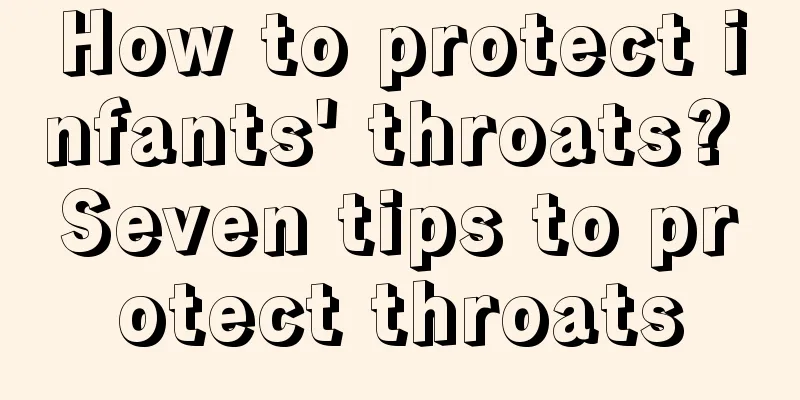There is a bad smell in the baby's ears. What's wrong? Is it caused by ear inflammation?

|
The ears are important organs that need our good care. So, what is the reason for the bad smell in the baby's ears? What is the cause of the bad smell in the baby's ears?A bad smell in your baby's ears may be caused by an ear infection. If you find yellow water flowing out of your baby's ears and there is a bad smell, it is best to go to the hospital for a check-up in time, because it is likely that there is some inflammation in the ears, or some ear diseases such as otitis media. Because we cannot see the internal structure of the ears from the outside, once there is a problem, it is not easy to be discovered, and parents should pay enough attention to it. What are the symptoms of otitis media in babiesOtitis media is an inflammation of the tympanic membrane of the middle ear, often caused by bacterial infection. Traditional Chinese medicine calls this disease "ear abscess" and "ear scurvy", and believes that it is caused by the prevalence of damp-heat (fire) in the liver and gallbladder. Otitis media is an inflammation of the middle ear and is a common disease. Otitis media often occurs in children under 8 years old, but also in people of other ages. It is often a painful complication of an upper respiratory tract infection such as the common cold or throat infection. Usually, otitis media is divided into acute and chronic otitis media. If acute otitis media is treated promptly, it can be cured and will not recur, but chronic otitis media cannot be cured. Chronic otitis media is usually transformed from acute otitis media and requires timely treatment. Seek medical attention promptly upon discovery When a child has otitis media, you should give him an antipyretic and analgesic solution and place the affected part on a hot water bottle wrapped with a wool patch. Fill the hot water bottle with warm water and place the painful side of the head downward to allow the exudate from the ear to drain out. If it is an infant with earache, place a soft towel close to the affected part. You should also take him to see a doctor within 24 hours. Beware of signs of illness It's important to see a doctor as soon as you suspect your child has an ear infection. To do this, you need to know the symptoms that indicate an ear infection. Older children will complain of pain or fullness in their ears when they have an ear infection. But younger children can't describe ear pain yet, so you need to watch for other signs that indicate an ear infection is coming, such as: your child pulling or scratching at his ears; having problems with hearing or balance; crying more than usual; or having fluid in the ears (symptoms of an infection include fever, crying, scratching the ears, nausea, and vomiting). Treatment of otitis media in childrenTreatment of the cause, clearing the lesion, keeping the nasal cavity clear, preventing dirty water from entering the ears, and preventing secondary infection. Different types of treatment are different: 1. Catarrhal otitis media In the early stage, drug treatment can be tried: 1% ephedrine nasal drops, appropriate antihistamines and adrenocortical hormones. If it is ineffective, tympanic membrane puncture should be performed to extract the effusion; in severe cases, hyaluronidase or cortisone acetate can be injected at the same time. If the condition recurs, tympanic membrane incision or coarse needle puncture can be performed, and a small drainage tube can be inserted, which can be left in place for the time being and observed for a long time. The tube often falls out by itself, and the perforation heals itself. 2. Acute suppurative otitis media Systemic treatment is required, including analgesia, sedation, and adequate antibiotics. If the eardrum is bulging, drainage should be performed through incision. If perforation has occurred and the perforation is too small, the incision should be enlarged to facilitate drainage. The secretions should be collected for bacterial culture and drug sensitivity testing. The ear canal should be cleared of pus at any time, and it can be cleaned with hydrogen peroxide, and ear drops or eye drops containing antibiotics can be used for ear drops, etc. Closely monitor the condition. If pus discharge persists, pay attention to complications of papillitis. If there are symptoms of meningeal irritation, extracranial and extracranial complications should be excluded. Once discovered, surgical treatment should be performed. 3. Chronic suppurative otitis media (1) For simple secretion bacterial culture, use ear drops that are sensitive to bacteria. If the pus is reduced and only a small amount of mucus is left, 4% boric acid alcohol or 1% chloramphenicol glycerol can be used. Powders such as iodine boric acid powder and chloramphenicol boric acid powder can be used. If the dry ear has not recurred for more than 3 months, tympanoplasty can be considered to repair the eardrum and improve hearing. (2) The necrotizing type is first treated with drugs. If this is ineffective, surgery should be performed to remove the lesions, granulation tissue, and necrotic tissue. (3) For cholesteatoma-type, small epitympanic cholesteatoma, conservative treatment can be performed first, such as repeated puncture and flushing with 95% alcohol through the epitympanic perforation, and keeping it dry. For mastoid cholesteatoma, radical mastoidectomy should be performed first, mainly to completely remove the lesion, and long-term observation should be performed. How to prevent otitis media in children1. Teach your child the correct way to blow their nose. Because colds are the biggest cause of otitis media, when children are 3-6 years old, they also start to go to kindergarten independently. If they blow their nose incorrectly, it will often induce otitis media. Parents should first teach their children the correct way to blow their nose. Parents should teach their children to blow their nose gently and not too hard, otherwise it will cause ear infection. Children should also be taught not to pinch their noses to hold back sneezes, because this will also allow the infection to enter the ears. 2. Reduce the chances of children being in unclean environments: As a parent, the first thing to do is to quit smoking. Children living with smokers seem to be more likely to suffer from otitis media than those in smoke-free families. Cigarettes can irritate the lining of the nasal passages and the middle ear cavity, thereby interfering with the normal activity of the Eustachian tube. If you can't quit smoking, at least don't smoke at home. At the same time, reduce the chances of children being in unclean environments. If you go swimming in a swimming pool, you also need to choose a clean swimming pool and not swim in dirty waters. If water accidentally flows into the ears, dry the ears in time, pull the outer ear upward and outward, and straighten the ear canal. Keep the hair dryer 5-10 cm away from the ears and blow into the ears. Blow with warm or cold air for 30 seconds. This can eliminate the warm and humid environment for the growth of bacteria and mold. 3. Keep your child away from the source of disease. Otitis media is mostly caused by colds or other upper respiratory tract infections. Keeping your child away from sick children will help reduce the risk of ear infections. If your child has allergic rhinitis, controlling the condition will also help prevent ear infections. When choosing a daycare center for your child, you should check how the center handles sick children. 4. Be alert to the signs. It is very important to see a doctor as soon as possible if you suspect your child has an ear infection. That is why parents need to know the symptoms that indicate an ear infection. When an ear is infected, older children will complain of pain or fullness in the ear. But younger children cannot describe ear pain yet, so parents need to watch for other signs that indicate an ear infection is about to occur, such as: the child pulling or scratching the ear, hearing or balance problems, crying more than usual, and fluid coming out of the ear (symptoms of an infection include fever, crying, scratching the ear, nausea and vomiting). 5. Be careful when feeding with a bottle. Avoid feeding milk or other baby foods with a bottle while the baby is lying on his back, because when the baby swallows while lying down, the nutrient-rich liquid can flow into the Eustachian tube and pool, creating a very comfortable breeding ground for infectious organisms. |
<<: How long does it take for a baby's hearing to fully develop? 12 months or more
>>: Can newborns with nasal congestion drink ginger water? Generally not recommended
Recommend
How to encourage children to get closer to them
In class management, emotional conflicts are a di...
What should I do if my baby likes to sleep on his knees? Reasons why my baby likes to sleep on his knees
When babies sleep, mothers always take good care ...
What effect does eating blueberries have on the fetus when pregnant? What should you pay attention to when eating blueberries during breastfeeding?
Many people like to eat blueberries, which are ri...
Is spanking a child a crime? What are the effects of spanking on children?
When children are disobedient, many Chinese paren...
When should I start drinking the tea for smooth delivery? Can the tea help with smooth delivery?
Natural childbirth is what almost all women hope ...
Can Omo sterilizing liquid be used to wash underwear? Can Omo sterilizing liquid be used together with laundry detergent?
Compared with disinfectant, sterilizing liquid is...
What time does the baby go to bed at night to help him grow taller? The benefits of early bedtime and early rise for children
Night is the golden period for babies to grow tal...
How long after giving birth can I practice Pilates? Pay attention to the intensity of exercise
Generally speaking, if you give birth naturally, ...
What is the problem with babies who like to bang their heads? What should I do if my baby likes to bang his head?
The baby's behavior and actions concern the p...
Does skin care products used by breastfeeding mothers have any effect on the baby? Can skin care products be used during breastfeeding?
Everyone loves beauty. Many mothers sacrifice a l...
Is it good to eat sesame paste before pregnancy? What are the benefits of eating sesame paste before pregnancy
Sesame paste can be paired with a variety of deli...
Will babies and milk powder cause internal heat? What should I do if my baby gets internal heat?
How much do you know about babies getting angry? ...
Is it good to eat durian during breastfeeding? Does eating durian during breastfeeding increase milk production?
A mouthful of durian is like three chickens. This...
Can babies drink mung bean water? Can babies drink mung bean soup?
Can babies drink mung bean soup? In summer, many ...
When does a baby learn to speak? How to teach a baby to speak?
After a baby is born, the baby's changes are ...









